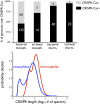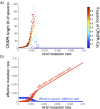Viral diversity threshold for adaptive immunity in prokaryotes
- PMID: 23221803
- PMCID: PMC3517865
- DOI: 10.1128/mBio.00456-12
Viral diversity threshold for adaptive immunity in prokaryotes
Abstract
Bacteria and archaea face continual onslaughts of rapidly diversifying viruses and plasmids. Many prokaryotes maintain adaptive immune systems known as clustered regularly interspaced short palindromic repeats (CRISPR) and CRISPR-associated genes (Cas). CRISPR-Cas systems are genomic sensors that serially acquire viral and plasmid DNA fragments (spacers) that are utilized to target and cleave matching viral and plasmid DNA in subsequent genomic invasions, offering critical immunological memory. Only 50% of sequenced bacteria possess CRISPR-Cas immunity, in contrast to over 90% of sequenced archaea. To probe why half of bacteria lack CRISPR-Cas immunity, we combined comparative genomics and mathematical modeling. Analysis of hundreds of diverse prokaryotic genomes shows that CRISPR-Cas systems are substantially more prevalent in thermophiles than in mesophiles. With sequenced bacteria disproportionately mesophilic and sequenced archaea mostly thermophilic, the presence of CRISPR-Cas appears to depend more on environmental temperature than on bacterial-archaeal taxonomy. Mutation rates are typically severalfold higher in mesophilic prokaryotes than in thermophilic prokaryotes. To quantitatively test whether accelerated viral mutation leads microbes to lose CRISPR-Cas systems, we developed a stochastic model of virus-CRISPR coevolution. The model competes CRISPR-Cas-positive (CRISPR-Cas+) prokaryotes against CRISPR-Cas-negative (CRISPR-Cas-) prokaryotes, continually weighing the antiviral benefits conferred by CRISPR-Cas immunity against its fitness costs. Tracking this cost-benefit analysis across parameter space reveals viral mutation rate thresholds beyond which CRISPR-Cas cannot provide sufficient immunity and is purged from host populations. These results offer a simple, testable viral diversity hypothesis to explain why mesophilic bacteria disproportionately lack CRISPR-Cas immunity. More generally, fundamental limits on the adaptability of biological sensors (Lamarckian evolution) are predicted.
Importance: A remarkable recent discovery in microbiology is that bacteria and archaea possess systems conferring immunological memory and adaptive immunity. Clustered regularly interspaced short palindromic repeats (CRISPR) and CRISPR-associated genes (CRISPR-Cas) are genomic sensors that allow prokaryotes to acquire DNA fragments from invading viruses and plasmids. Providing immunological memory, these stored fragments destroy matching DNA in future viral and plasmid invasions. CRISPR-Cas systems also provide adaptive immunity, keeping up with mutating viruses and plasmids by continually acquiring new DNA fragments. Surprisingly, less than 50% of mesophilic bacteria, in contrast to almost 90% of thermophilic bacteria and Archaea, maintain CRISPR-Cas immunity. Using mathematical modeling, we probe this dichotomy, showing how increased viral mutation rates can explain the reduced prevalence of CRISPR-Cas systems in mesophiles. Rapidly mutating viruses outrun CRISPR-Cas immune systems, likely decreasing their prevalence in bacterial populations. Thus, viral adaptability may select against, rather than for, immune adaptability in prokaryotes.
Figures




Similar articles
-
CRISPR-Cas: evolution of an RNA-based adaptive immunity system in prokaryotes.RNA Biol. 2013 May;10(5):679-86. doi: 10.4161/rna.24022. Epub 2013 Feb 25. RNA Biol. 2013. PMID: 23439366 Free PMC article. Review.
-
Pseudo-chaotic oscillations in CRISPR-virus coevolution predicted by bifurcation analysis.Biol Direct. 2014 Jul 2;9:13. doi: 10.1186/1745-6150-9-13. Biol Direct. 2014. PMID: 24986220 Free PMC article.
-
Evolutionary dynamics of the prokaryotic adaptive immunity system CRISPR-Cas in an explicit ecological context.J Bacteriol. 2013 Sep;195(17):3834-44. doi: 10.1128/JB.00412-13. Epub 2013 Jun 21. J Bacteriol. 2013. PMID: 23794616 Free PMC article.
-
CRISPR-Cas systems and RNA-guided interference.Wiley Interdiscip Rev RNA. 2013 May-Jun;4(3):267-78. doi: 10.1002/wrna.1159. Epub 2013 Mar 20. Wiley Interdiscip Rev RNA. 2013. PMID: 23520078 Review.
-
Clustered regularly interspaced short palindromic repeats (CRISPRs): the hallmark of an ingenious antiviral defense mechanism in prokaryotes.Biol Chem. 2011 Apr;392(4):277-89. doi: 10.1515/BC.2011.042. Epub 2011 Feb 7. Biol Chem. 2011. PMID: 21294681 Review.
Cited by
-
Holding a grudge: persisting anti-phage CRISPR immunity in multiple human gut microbiomes.RNA Biol. 2013 May;10(5):900-6. doi: 10.4161/rna.23929. Epub 2013 Feb 25. RNA Biol. 2013. PMID: 23439321 Free PMC article.
-
CRISPR-Cas: evolution of an RNA-based adaptive immunity system in prokaryotes.RNA Biol. 2013 May;10(5):679-86. doi: 10.4161/rna.24022. Epub 2013 Feb 25. RNA Biol. 2013. PMID: 23439366 Free PMC article. Review.
-
Probabilistic models for CRISPR spacer content evolution.BMC Evol Biol. 2013 Feb 26;13:54. doi: 10.1186/1471-2148-13-54. BMC Evol Biol. 2013. PMID: 23442002 Free PMC article.
-
CRISPRDetect: A flexible algorithm to define CRISPR arrays.BMC Genomics. 2016 May 17;17:356. doi: 10.1186/s12864-016-2627-0. BMC Genomics. 2016. PMID: 27184979 Free PMC article.
-
Visualization and prediction of CRISPR incidence in microbial trait-space to identify drivers of antiviral immune strategy.ISME J. 2019 Oct;13(10):2589-2602. doi: 10.1038/s41396-019-0411-2. Epub 2019 Jun 25. ISME J. 2019. PMID: 31239539 Free PMC article.
References
-
- Futuyma D. 2005. Evolution. Sinauer Associates, Sunderland, MA
-
- Lynch M. 2007. The origins of genome architecture. Sinauer Associates, Sunderland, MA
-
- Eyre-Walker A, Keightley PD. 2007. The distribution of fitness effects of new mutations. Nat. Rev. Genet. 8:610–618 - PubMed
Publication types
MeSH terms
Grants and funding
LinkOut - more resources
Full Text Sources
Other Literature Sources
Molecular Biology Databases

